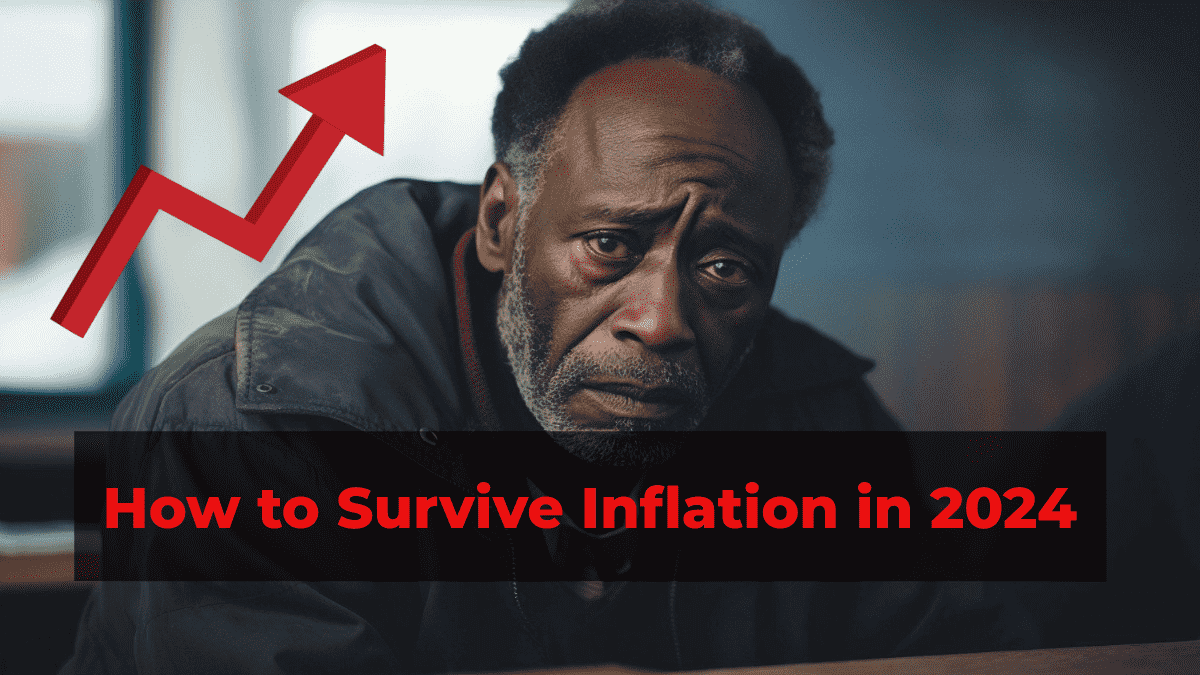Grocery bills soaring, gas prices skyrocketing – inflation is a word dominating headlines and dinner table conversations alike. But what exactly is inflation, and how is it impacting your wallet? Is it a temporary blip, or are we headed for a rough economic ride?
This comprehensive guide dives deep into the complexities of inflation in the U.S. in 2024. We’ll break down the latest updates, unpack the economic jargon, and explore the real-world consequences on everyday life. We’ll also provide actionable tips on how to navigate this financial roller coaster and emerge unscathed (or at least a little less bruised). Whether you’re a seasoned investor or simply trying to make ends meet, this guide will equip you with the knowledge and strategies to weather the storm of inflation in 2024.
*Escalation is used for Inflation in the article at some places to minimize word concentration.
Inflation in the U.S. 2024: A Year of Uncertainty and Potential Relief
The year 2024 has been a rollercoaster for the U.S. economy, with inflation taking center stage. While prices initially soared in 2022, hitting a peak of 9.1%, recent months have shown a slight decline. However, is this a sign of things to come, or is the worst yet to arrive? This comprehensive guide dives deep into the complexities of escalation in the U.S. in 2024, exploring the current situation, potential future scenarios, and its impact on everyday life.
Decoding the Numbers: What is the Current Inflation Rate in the U.S.?
As of March 2024, the Consumer Price Index (CPI), a key indicator of escalation, showed a year-over-year increase of 3.5%. This may seem like an improvement compared to the highs of 2022, but it’s still significantly above the Federal Reserve’s target rate of 2%. The core CPI, which excludes volatile food and energy prices, sits at 3.8%, indicating underlying inflationary pressures.
While these figures paint a broad picture, it’s important to remember how escalation affects different sectors. Housing costs, for example, have continued to rise at a concerning rate, with the shelter index in the CPI showing a 5.7% increase year-over-year. This puts a significant strain on household budgets.
Relief on the Horizon? Expert Predictions and Policy Responses
The Federal Reserve plays a crucial role in managing escalation. In 2023, it began raising interest rates to cool down the economy and curb price increases. The effectiveness of these measures is still being debated.
Federal Reserve Chair Jerome Powell has acknowledged that getting escalation back to the 2% target will take time. He expects escalation to decline throughout 2024, but recent data has tempered his optimism.
Looking outside the Fed’s toolkit, other factors could influence escalation in the U.S. in 2024. Easing supply chain constraints and a potential slowdown in global energy prices could provide some much-needed relief.
The Domino Effect: How Inflation Impacts the U.S. Economy
Rising inflation has a ripple effect throughout the U.S. economy. Here’s how it plays out:
Reduced Purchasing Power: As prices go up, the value of each dollar decreases, leading to a decline in purchasing power. This means consumers can afford less with the same amount of money.
Higher Interest Rates: As mentioned earlier, the Federal Reserve raises interest rates to combat escalation. This can lead to higher borrowing costs for businesses and individuals, potentially impacting investment and consumer spending.
Market Volatility: Inflationary periods often come with increased market volatility, creating uncertainty for investors and businesses.
The Human Cost: How Inflation Affects People’s Lives
Inflation doesn’t just affect economic numbers; it has a direct impact on people’s lives. Here are some ways rising prices affect individuals and families:
Increased Expenses: From groceries to rent, everyday necessities become more expensive, forcing people to tighten their belts.
Lower Standard of Living: With their purchasing power diminished, many households struggle to maintain their standard of living.
Wage Stagnation: Real wages (wages adjusted for escalation) may not keep pace with rising prices, leading to a decline in living standards.
Navigating the Storm: Tips to Cope with escalation in 2024
While the economic climate may seem challenging, there are ways to cope with escalation in 2024:
Create a Budget: Tracking your income and expenses helps identify areas where you can cut back.
Prioritize Needs: Focus on essential expenses like food and housing, and find ways to reduce discretionary spending.
Explore Cost-Saving Alternatives: Look for cheaper alternatives on groceries, utilities, and other expenses. Consider generic brands and shopping at discount stores.
Seek Higher-Yielding Savings Accounts: Escalation erodes cash value in traditional savings accounts. Look for accounts with higher interest rates to minimize the impact.
Invest in Assets that Hedge Inflation: Consider investing in assets that historically perform well during inflationary periods, such as real estate or certain commodities.
Is Stagflation on the Horizon?
While the U.S. economy is currently experiencing escalation, the bigger worry is whether it will be accompanied by stagnant or even declining economic growth. This combination, known as stagflation, can be particularly damaging as it limits the ability of the Fed to use traditional tools to combat inflation.
Here’s a closer look at the factors that could contribute to stagflation:
Geopolitical Tensions: Ongoing global conflicts and disruptions in the international trade system can exacerbate supply chain issues and push energy prices higher, further fueling escalation.
Labor Market Tightness: While currently robust, the U.S. labor market might face challenges. If wage hikes become excessive in an attempt to keep pace with escalation, it could lead to a cost-price spiral where businesses raise prices to cover increased labor costs, further fueling escalation.
Inflation vs. Recession: A Delicate Balancing Act
The Federal Reserve walks a tightrope in managing escalation. While its goal is to reduce prices, excessively aggressive interest rate hikes can trigger a recession, marked by declining economic activity and rising unemployment.
The Fed needs to strike a delicate balance between curbing escalation without suffocating economic growth.
Inflation in 2024 – A Dynamic Landscape
The future of inflation in the U.S. in 2024 remains uncertain. While there are signs of a potential slowdown, external factors and policy decisions can significantly impact the trajectory.
Understanding the complexities of escalation and its impact is crucial for navigating the current economic climate. By staying informed, adopting smart financial strategies, and remaining adaptable, individuals and businesses can better cope with the challenges and opportunities presented by escalation in 2024.
FAQs
Q: What is the difference between CPI and PCE?
A: Both CPI and PCE (Personal Consumption Expenditures) measure escalation, but they use slightly different methodologies. CPI tracks changes in the prices of a fixed basket of goods and services, while PCE reflects the spending patterns of consumers.
Q: Will inflation lead to higher wages?
A: Inflation can lead to wage increases, but it’s not guaranteed. It depends on factors like labor market tightness and the bargaining power of workers.
Q: How can the government help with inflation?
A: The government can take various measures to address escalation, including tax breaks, subsidies for essential goods, and strategic stockpiling of critical resources.
By understanding these concepts and staying informed about the latest updates, you can be better prepared to weather the storm of escalation in 2024.
Q: What are some investments that can hedge against inflation?
A: While past performance isn’t a guarantee of future results, some asset classes tend to perform well during inflation. These include:
Real estate: Historically, real estate values have increased alongside inflation.
Commodities: Commodities like gold, oil, and agricultural products can rise in price during inflationary periods.
Treasury Inflation-Protected Securities (TIPS): These government bonds adjust their principal value for inflation, protecting your purchasing power.
Q: Should I pay off debt early due to inflation?
A: If you have high-interest debt, prioritizing its repayment can be a good strategy. Inflation effectively reduces the real value of your debt over time, making it cheaper to pay off in the future. However, if your debt has a low-interest rate, it might be more beneficial to invest that money elsewhere.
Q: Is there a chance inflation will turn into deflation (falling prices)?
A: While unlikely in the near term, deflation can occur. However, it can also be problematic, leading to economic stagnation and hindering consumer spending.
Q: Where can I find reliable information about inflation?
A: Several resources offer reliable information about escalation in the U.S.:
U.S. Bureau of Labor Statistics (BLS): The BLS publishes the Consumer Price Index (CPI) data, a key measure of inflation.
Federal Reserve: The Federal Reserve website provides insights into its monetary policy decisions and their impact on inflation.
By staying informed about these resources and the evolving economic landscape, you can make informed financial decisions and navigate the challenges of inflation in 2024.







Keep it up 💯💯